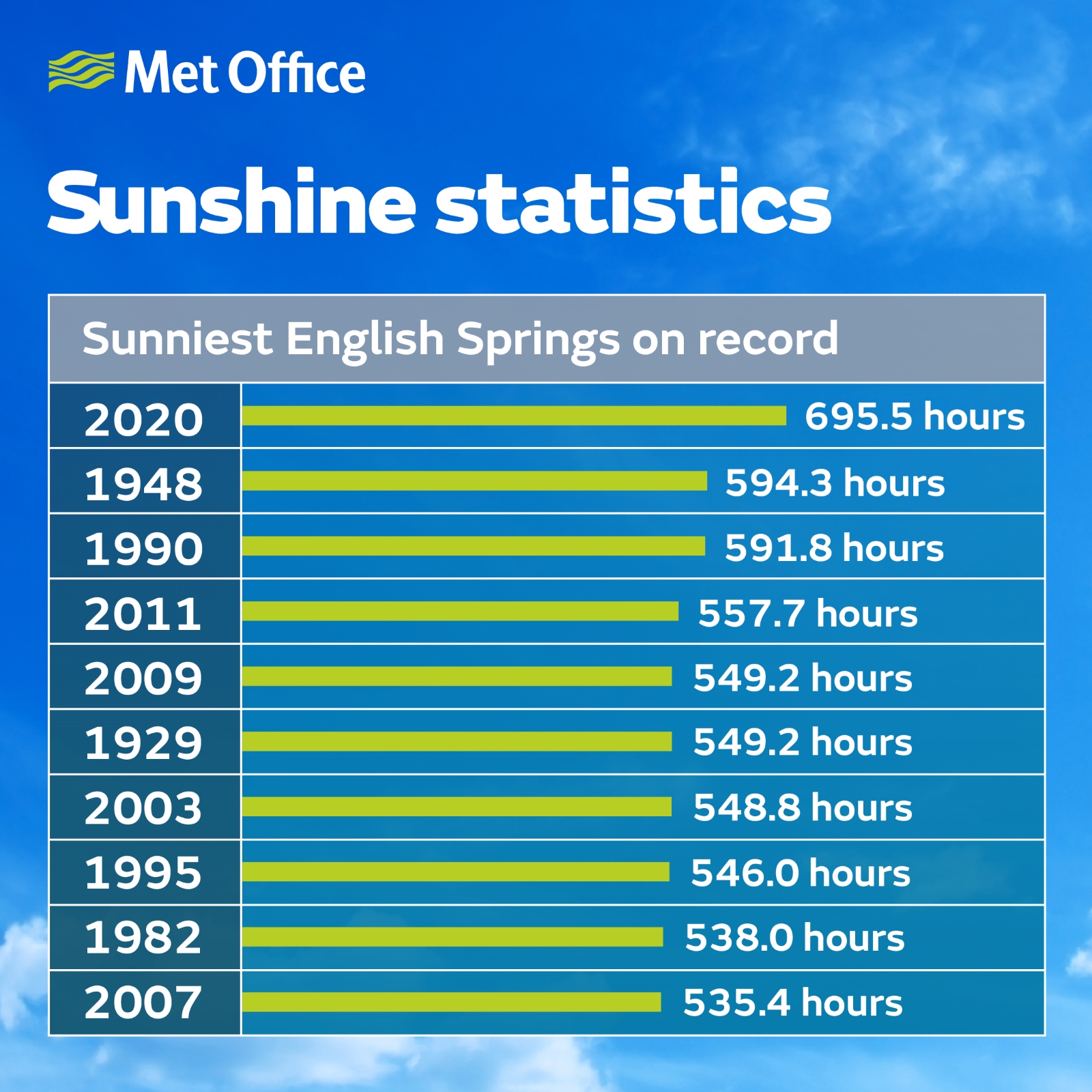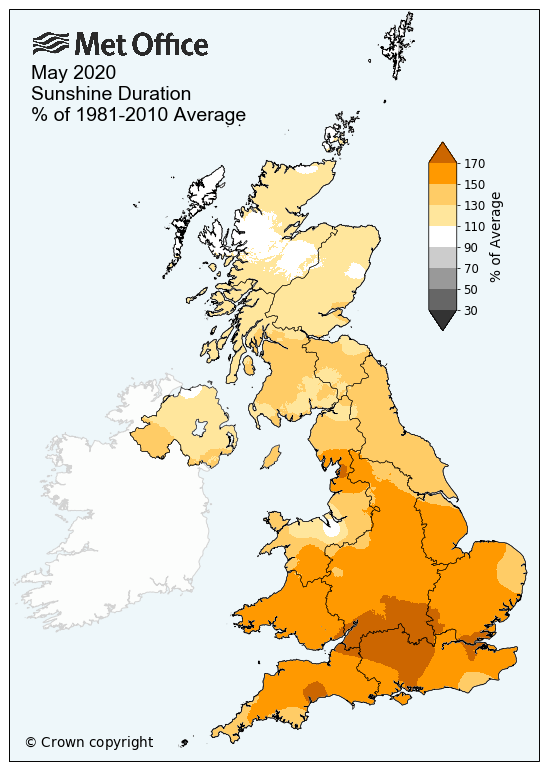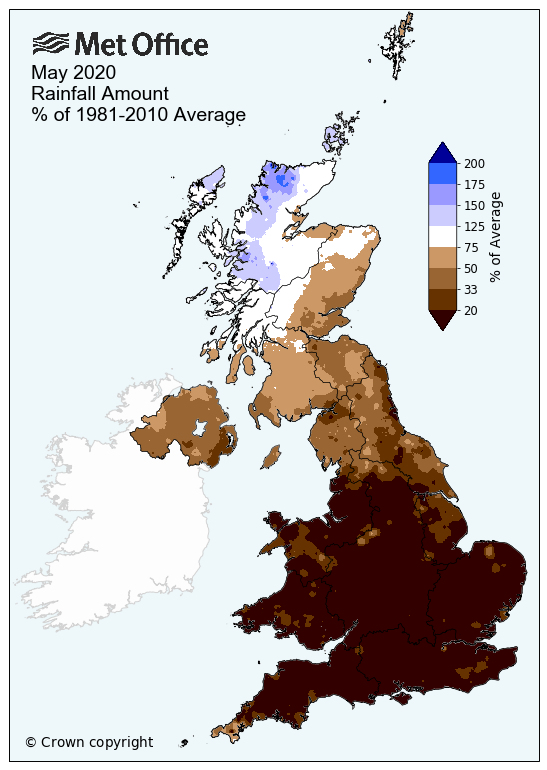May 2020 becomes the sunniest calendar month on record
Author: Grahame Madge
15:30 (UTC+1) on Mon 1 Jun 2020
May has become the sunniest calendar month on record in the UK
It has been the sunniest Spring on record for the UK and all the home nations and the driest May on record in England.
Spring 2020 headlines
- 626 hours of bright sunshine were recorded in Spring 2020 for the UK and have exceeded the previous high (555 hours, set in 1948) by over 70 hours. Spring 2020 also exceeds the sunshine amount for most summer seasons, with only three summers being sunnier (1976, 1995, and 1989).
- The figure for England is even higher. Spring 2020 recorded 696 hours of sunshine, exceeding the previous record set of 594.3 hours
- All UK countries have recorded their sunniest spring on record in series stretching back to 1929
- It has been the eighth warmest spring on record for the UK, with both England and Wales having their fifth warmest spring on record
- It has been the fifth driest spring for the UK overall, but some counties in north east England and eastern Scotland have recorded their driest spring in a rainfall series from 1862.

May 2020 headlines
- Warm weather at the end of May offset cooler conditions earlier in the month, the month was warmer than average but not exceptionally so.
- UK, England and Wales also recorded their sunniest May on record (in a series from 1929)
- May 2020 has been the sunniest calendar month on record with 266 hours of sunshine, beating the previous record of 265 hours in June 1957.
- It has been the driest May in England and second driest in Wales with 9.6mm and 14.3mm respectively, which are both just 17% of the average rainfall for May.
Dr Mark McCarthy is the head of the Met Office’s National Climate Information Centre. He said: “The most remarkable aspect is just how much some of the May and Spring records for these climate statistics have been exceeded. Exceeding the UK sunshine record is one thing, but exceeding by over 70 hours is truly exceptional.
“The sunshine figures for spring would even be extremely unusual for summer and only three summers would beat Spring 2020 for sunshine hours.
“The principal reason for the dry and sunny weather is the extended period of high pressure which has been centred over or close to the UK. This has suppressed the development of clouds and rainfall over the UK, while allowing plenty of sunshine to reach the surface. There has been a band of similar weather conditions extending across central parts of Europe, whereas Iberia and parts of Scandinavia have experienced rather wetter conditions.”

An exceptionally dry spring
Commenting on the relative lack of rainfall, Harvey Bradshaw, Executive Director for Environment and Business, Environment Agency, said: “This has been an exceptionally dry spring, we have seen a fall in river flows and reservoir levels. However, at this time most water companies across the country have appropriate water reserves for this time of year.
“We work closely with all water companies to ensure their drought plans are up to date and activated as needed. Some will be following their plans as a precaution. We can all do our part to use water wisely and manage this precious resource, simple steps such as fitting a trigger to your hose or using a bucket to wash the car or water plants can make a difference.”
Water UK Chief Executive Christine McGourty added: “These are exceptional times and the record-breaking dry weather is a powerful reminder of what a precious, natural resource our water is. With so many people at home and enjoying their gardens, water companies are seeing record demand for water, which can cause issues with water pressure. Working together, we can all make a difference right now, so let’s use water wisely. We need to keep washing our hands, but make other small changes to our water use, for example cutting back on paddling pools and sprinklers, particularly at the peak times in the evening.”


|
|
Maximum temperature | Minimum temperature | Mean temperature | Precipitation | Sunshine duration | |||||
|---|---|---|---|---|---|---|---|---|---|---|
|
Area |
Act deg °C |
Anom 8110 deg °C |
Act deg °C |
Anom 8110 deg °C |
Act deg °C |
Anom 8110 deg °C |
Act mm |
Anom 8110 % |
Act hours |
Anom 8110 % |
|
UK |
13.38 | 1.67 | 3.98 | 0.15 | 8.65 | 0.91 | 139.7 | 59.0 | 626.2 | 144.0 |
|
England |
14.69 | 2.01 | 4.62 | 0.22 | 9.65 | 1.12 | 86.7 | 48.0 | 695.0 | 153.0 |
|
Wales |
13.88 | 2.06 | 4.43 | 0.19 | 9.11 | 1.11 | 149.3 | 51.0 | 640.7 | 144.0 |
|
Scotland |
11.15 | 1.08 | 2.77 | 0.03 | 6.92 | 0.56 | 227.7 | 72.0 | 518.4 | 128.0 |
|
N Ireland |
13.04 | 1.25 | 4.14 | 0.12 | 8.57 | 0.67 | 125.3 | 52.0 | 564.4 | 132.0 |
‘Act’ – refers to the actual average value in the units given
‘Anom 8110’ – refers to the anomaly relative to a 1981-2010 baseline climatology given as a difference (temperature) or as a percentage (rainfall and sunshine)
|
|
Maximum temperature | Minimum temperature | Mean temperature | Precipitation | Sunshine duration | |||||
|---|---|---|---|---|---|---|---|---|---|---|
|
Area |
Act deg °C |
Anom 8110 deg °C |
Act deg °C |
Anom 8110 deg °C |
Act deg °C |
Anom 8110 deg °C |
Act mm |
Anom 8110 % |
Act hours |
Anom 8110 % |
|
UK |
16.7 | 1.9 | 6.1 | 0.1 | 11.3 | 1.0 | 32.7 | 47.0 | 265.5 | 143.0 |
|
England |
18.1 | 2.3 | 6.6 | -0.1 | 12.4 | 1.1 | 9.6 | 17.0 | 299.4 | 157.0 |
|
Wales |
17.0 | 2.1 | 6.2 | -0.2 | 11.6 | 1.0 | 14.3 | 17.0 | 281.3 | 150.0 |
|
Scotland |
14.4 | 1.3 | 5.1 | 0.3 | 9.6 | 0.8 | 76.0 | 90.0 | 212.0 | 119.0 |
|
N Ireland |
16.0 | 1.5 | 6.3 | 0.3 | 11.1 | 0.9 | 30.6 | 42.0 | 226.7 | 124.0 |
‘Act’ – refers to the actual average value in the units given
‘Anom 8110’ – refers to the anomaly relative to a 1981-2010 baseline climatology given as a difference (temperature) or as a percentage (rainfall and sunshine)





